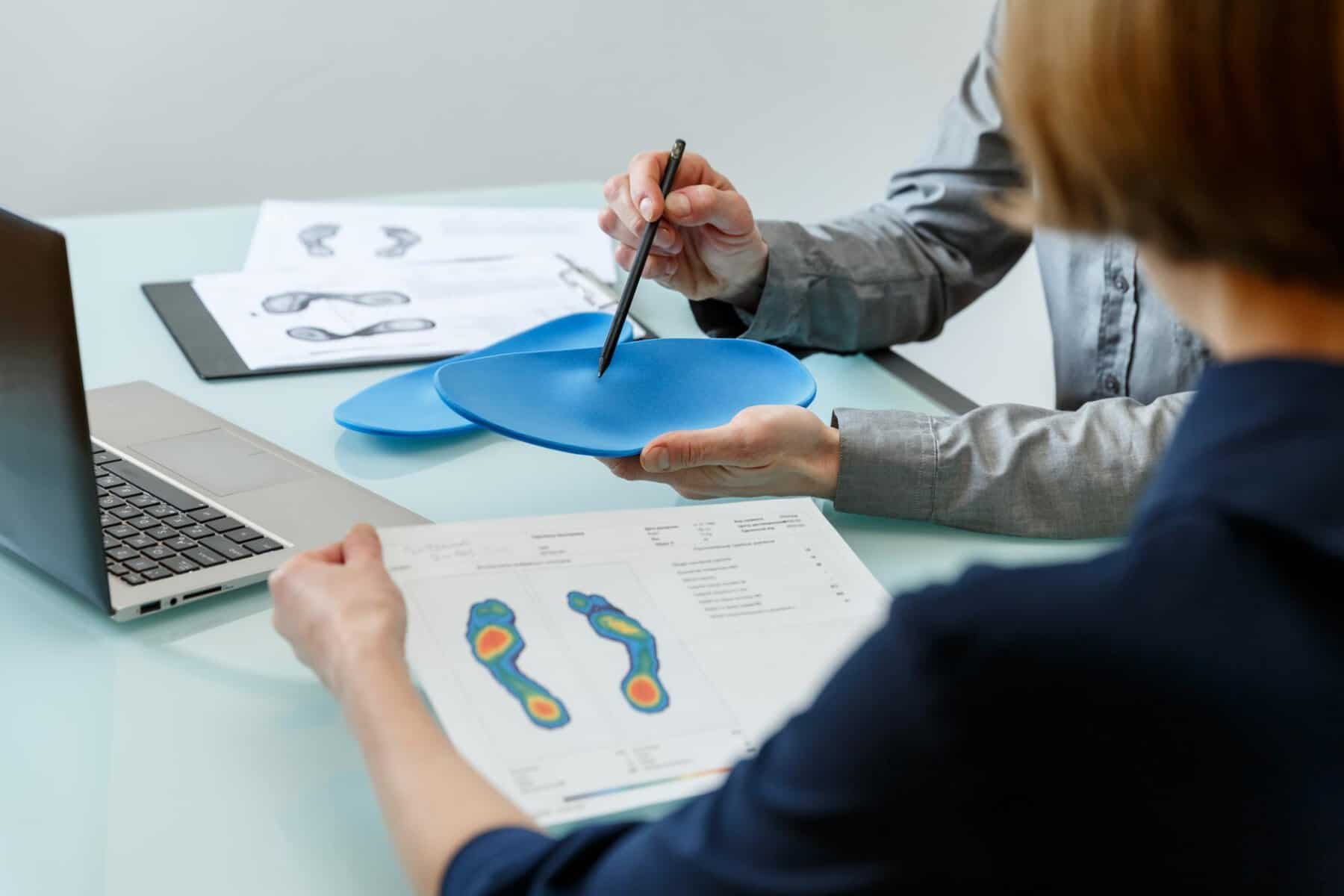
What Is Orthotic Therapy?
Orthotic therapy is a specialised approach we use to support and correct the structure and function of your feet and body. Just as glasses help correct vision, orthotic devices are designed to support your body in a way that can remove pain, correct misalignment, and improve mobility.
We combine these orthoses with a custom treatment plan that could involve stretches and exercises, massage, shockwave therapy, and other techniques.
This article will focus on orthotic therapy for lower limb conditions. We’ll look at how orthotics are used, conditions treated, the benefits, and if orthotic therapy is right for you.
How Orthoses Are Used in Orthotic Therapy

Orthoses are the technical term for these devices and are simply a tool in the treatment process. They take pressure away from areas that can’t handle it, and put it in ones that are more appropriate so that the tissue can settle down.
Sometimes that means changing the way that you’re actually walking. Sometimes that means changing where your foot is contacting the ground. And sometimes it simply means giving you a little bit of support so the joints and ligaments that are struggling don’t have to work quite as hard.
In podiatric care, treating foot and lower limb issues often involves both in-clinic treatments and home-based therapy, with orthotics playing a key role at home. Here’s a closer look:
In-Clinic Treatments
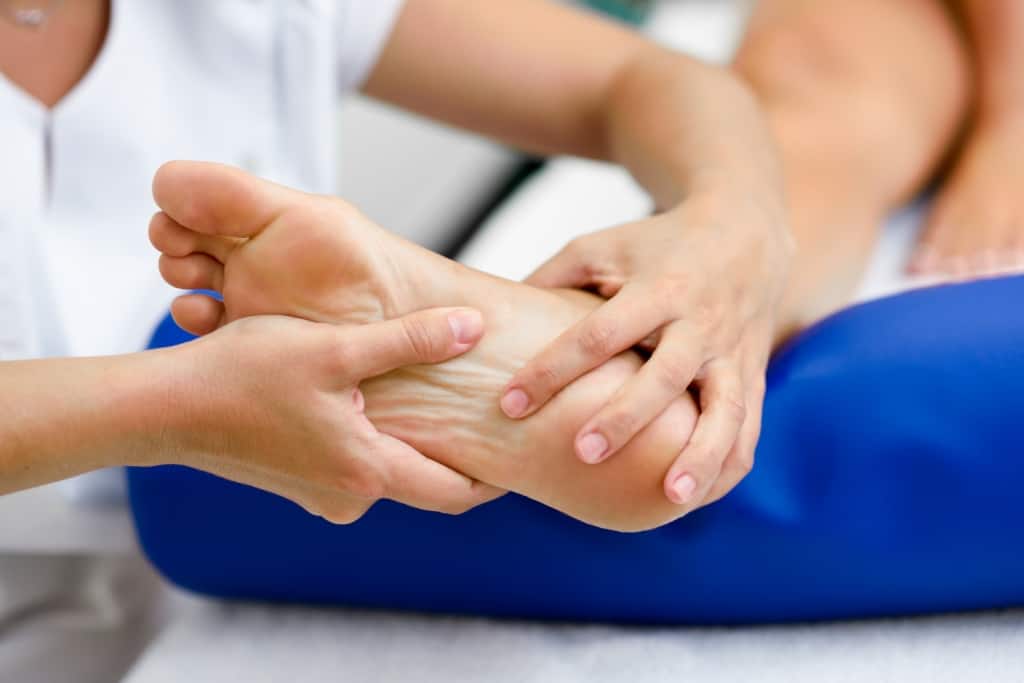
Here in the clinic, we tailor our treatments to your specific case. These treatments could include:
- Massage Therapy: Relaxes muscles, eases tension, and boosts blood flow.
- Shockwave Therapy: A modern, non-invasive method using shock waves for quicker tissue healing.
- Exercises and Stretches: To strengthen muscles, enhance flexibility, and boost joint health.
- Ultrasound Therapy: Uses sound waves for healing and reducing swelling.
- Manual Adjustments: We sometimes adjust feet or limbs for better alignment and function.
Role of Orthotics at Home

Orthotics come into play primarily when you’re going about your daily life, outside of our clinic. They’re incredibly important for several reasons:
- Support: Orthotics provide necessary structural support, keeping your foot and lower limb in alignment and relieving strain on problematic areas.
- Prevention: By correcting the mechanics of your foot, orthotics help prevent existing conditions from worsening and reduce the risk of new injuries.
- Healing: Alongside the treatments you receive here, orthotics are designed to aid in your body’s natural healing process by taking the stress off damaged and sensitive areas.
- Daily Life: They also make your daily activities more manageable, enabling you to stay active and maintain your independence while under treatment.
In essence, the work we do in the clinic provides immediate relief and sets the stage for healing. Meanwhile, orthotics make sure that your body can continue to heal at home by taking the stress off problem areas.
Types of Orthotics
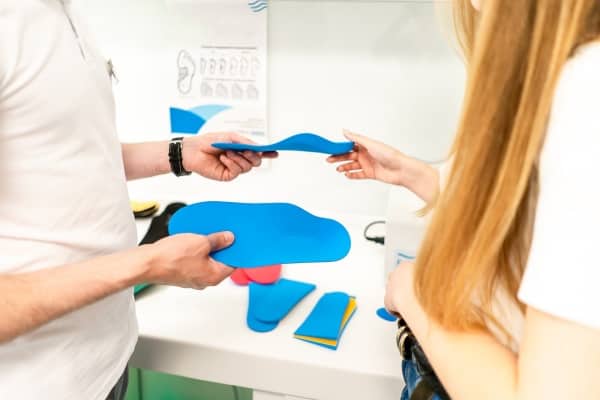
Orthotics come in many shapes and sizes. Some are as simple as shoe inserts you can buy at a store, which might help with minor issues and discomfort.
But many conditions need a more tailored solution, which is where custom-made orthotics come into play. These are made specifically for your body’s needs based on a thorough examination and analysis of how you walk, stand, and move.
For example, if you’re dealing with flat feet, custom orthotics can provide the support your feet are missing for them to function normally.
I typically suggest custom or high-quality semi-custom orthotics for the best fit and support. Your choice depends on your condition’s severity, daily activities, and budget. Custom orthotics are usually best for serious issues. For minor problems or short-term needs, quality off-the-shelf options can work well.
To learn more about the different types of orthotics, click here.
Conditions Treated by Orthotic Therapy
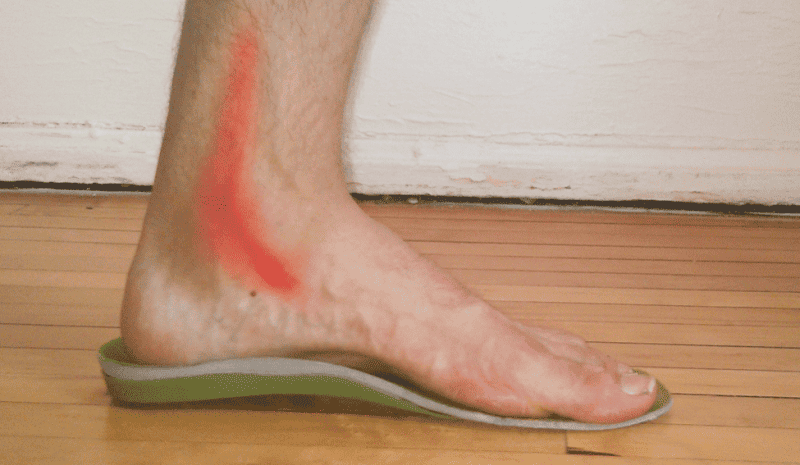
Orthotic therapy can treat numerous foot conditions and reduce foot pain. But they can also be used to treat other lower limb conditions – from your achilles all the way up to your back. Let’s go through some of these.
Plantar Fasciitis
If you’re waking up with sharp heel pain, it’s a common sign of this condition. Using orthotics can support your arch and lessen the strain on your plantar fascia, which should help ease that pain.
Flat Feet
For those who have low arches or flat feet, pain and instability can be a real problem. I can customise orthotics to give you the arch support you need, helping to relieve your discomfort.
Bunions and Hammertoes
With these conditions, the key is to redistribute excessive forces away from sensitive areas and align your toes in a more natural position. Orthotics can be designed to do just that. We might also recommend some more ergonomic shoes for you to wear.
Diabetic Foot Complications
For patients with diabetes, especially those suffering from diabetic neuropathy, there are special orthotics available. These custom foot orthoses can prevent ulcers by alleviating pressure points and enhancing blood flow, which is crucial for your foot health.
Arthritis
If arthritis is causing pain in your feet and ankles, orthotics can provide the cushioning and support needed to reduce the stress on your joints.
Overpronation and Underpronation
This is where your foot rolls inward or outward too much. This can lead to misalignment issues, discomfort, and injuries. Orthotics can correct this misalignment, helping to improve your walking pattern and reduce pain.
Achilles Tendinitis
Achilles tendinitis is another condition where orthotics can help by lessening the strain on your Achilles tendon.
Knee Pain
Knee pain, such as that from runner’s knee, often stems from issues with foot and ankle alignment. By improving the alignment of your legs through orthotics, we can reduce the stress on your knees.
Back Pain
Even back pain can sometimes be traced back to foot and walking issues. Orthotics can improve your posture and the way you walk, which may help reduce your back pain.
Sports Injuries
And for the athletes among you, orthotics are often used to prevent overuse injuries and enhance performance. This is done by improving foot function and alignment.
Orthotic therapy isn’t restricted to only these conditions. It can help with any condition where foot function and alignment affect pain or mobility. The Lower Limb Clinic can assess your needs to see if orthotics are right for you.
Process of Getting Orthotics

The process starts with me getting a good understanding of your condition. During this appointment, I’ll conduct a biomechanical assessment, observe how you walk (commonly referred to as a gait analysis), and discuss any pain you’re experiencing. We might use a treadmill, a pressure plate, or conduct other tests to get a clear picture of your needs.
Next, if we decide that custom orthotics are right for you, I’ll make a precise mould of your feet. This can be done through traditional plaster casting or by using modern 3D scanning technology to capture the unique contours of your feet.
Once we have the mould, I’ll design your orthotics to correct any misalignments, supporting your feet in just the right places, and relieving pressure points.
After designing your orthotics, the specifications are sent to a lab where we hand-make them using materials selected to meet your unique needs. For example, we might choose softer materials for diabetic foot care or firmer ones for structural support.
When your orthotics are ready, you’ll come back to try them on. We’ll ensure they fit well in your shoes and make any adjustments needed to guarantee comfort and functionality.
A follow-up appointment is standard practice to see how you’re getting on with your new orthotics. If you’re experiencing any discomfort or if further adjustments are necessary, we’ll take care of it then.
The Benefits of Wearing Orthotics
Orthotic therapy brings many benefits over other treatments.
Non-Invasive: One of the biggest perks is that orthotics offer a way to manage pain, alignment, and functional issues without surgery. This approach is much less risky and is often the first line of treatment I recommend.
Pain Relief throughout the day: Orthotics work by correcting misalignments and redistributing pressure more evenly across your foot. This can lead to significant pain relief not just in your feet, but also in your ankles, knees, hips, and even lower back.
Improved Mobility: If you’re finding daily activities challenging due to mobility issues, orthotics can help make walking and moving around much easier and less painful.
Preventive Care: Orthotic therapy can prevent the progression of certain foot conditions and joint degeneration, as well as reduce the risk of injuries by ensuring your feet are properly aligned and functioning correctly.
Versatility: Another bonus is that orthotics can be made for a wide variety of footwear, so whether you’re in athletic shoes, work boots, or dress shoes, you can have the support you need to get on with your day.
Synergy with Other Treatments: Orthotics can be part of a broader treatment plan, complementing physical therapy, medications, and exercises. This holistic approach can significantly improve your treatment outcomes.
Long-term Solution: While some treatments might only offer temporary relief, orthotics aim to address the root cause of your issues for lasting benefits. With proper maintenance, they can provide support over a long period.
Cost-Effective: When compared to the costs of surgery or long-term medication, orthotics are a more economical solution that offers enduring benefits without ongoing treatment expenses.
Orthotic therapy isn’t a one-size-fits-all solution. Its effectiveness for you will depend on an accurate assessment of your condition, precise customisation of the orthotics, and their proper use as part of your treatment plan. That’s something we work on together to ensure we find the best approach for your specific needs.
Who Can Benefit from Orthotic Therapy?
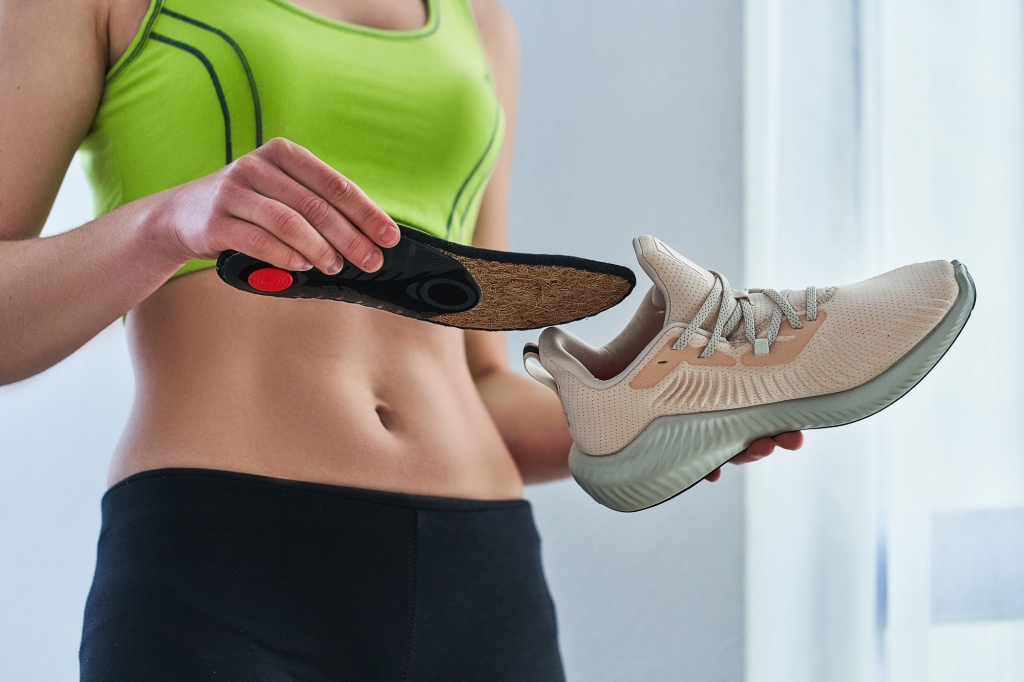
Orthotic therapy can benefit a lot of people, whether you’re dealing with specific chronic foot conditions or just looking for extra comfort in your day-to-day life or at your job. Let’s talk about who might benefit from this:
- People with foot deformities or issues like plantar fasciitis, flat feet, high arches, bunions, hammertoes, or neuromas.
- Athletes and runners often use orthotics to help prevent injuries, improve their performance, and address any biomechanical problems they might have.
- Patients with diabetes, particularly those experiencing diabetic neuropathy.
- Sufferers of arthritis
- People who are on their feet all day, like workers in healthcare, retail, or hospitality.
- Children who have foot problems or abnormal walking patterns – orthotics can provide pain relief and support during their growth phases.
- Orthotics also offer great support for elderly individuals, helping to maintain mobility and lower the risk of falls.
- Even people experiencing back, hip, or knee pain can also find relief from orthotics in some cases
Before we decide on orthotic therapy, I’d conduct a thorough assessment to ensure they’re the right choice for you.
How to Pick the Right Podiatrist for Orthotic Therapy
Finding the right podiatrist for orthotic therapy is key for the best care and results. Consider these factors:
Specialisation: Choose a podiatrist who focuses on orthotic therapy. They should be up-to-date with the latest treatments and tech.
Experience and Reputation: Look for a podiatrist with a strong history of treating patients with orthotics. Read reviews and patient feedback where orthotics are mentioned. A strong community reputation indicates effective treatments and happy patients.
Facilities: The clinic should have modern tools and technology for precise assessments and custom made orthotic device manufacturing.
Patient Care: Your podiatrist should listen to your needs and concerns. They should offer a thorough assessment and personalised treatment.
Follow-up Care: After getting your orthotics, the podiatrist should provide follow-up visits to make any needed adjustments and address concerns.
Don’t let foot pain slow you down

Whether you’re facing ongoing pain, a sports injury, or just want more comfort day-to-day, orthotic therapy can provide real relief and support.
If you’re in Melbourne and need help with a lower limb condition, book a biomechanical assessment and gait analysis with The Lower Limb Clinic. New patients can get their assessment Gap-Free! But it’s limited to 3 spots per week so book early.
